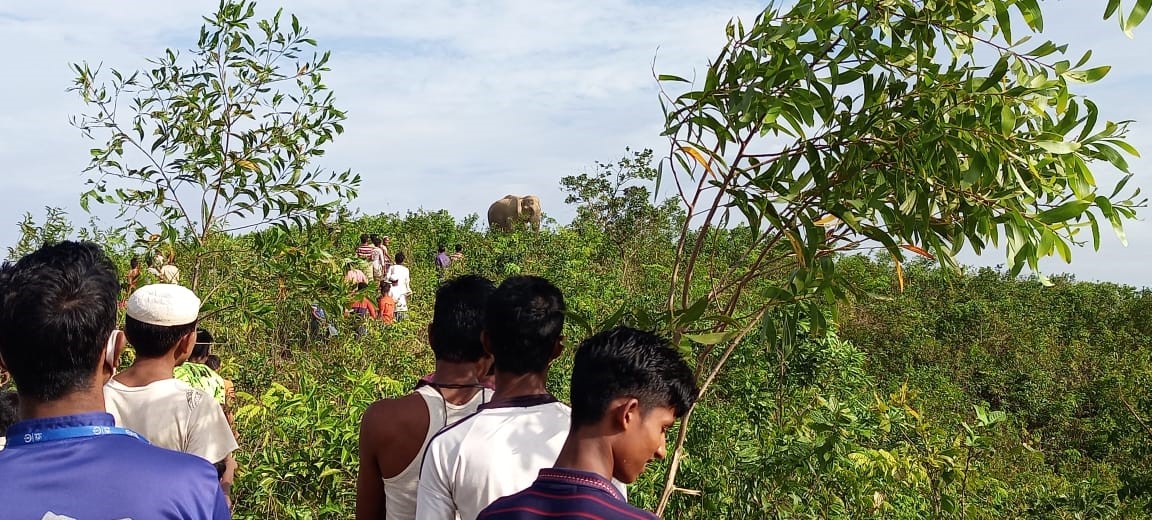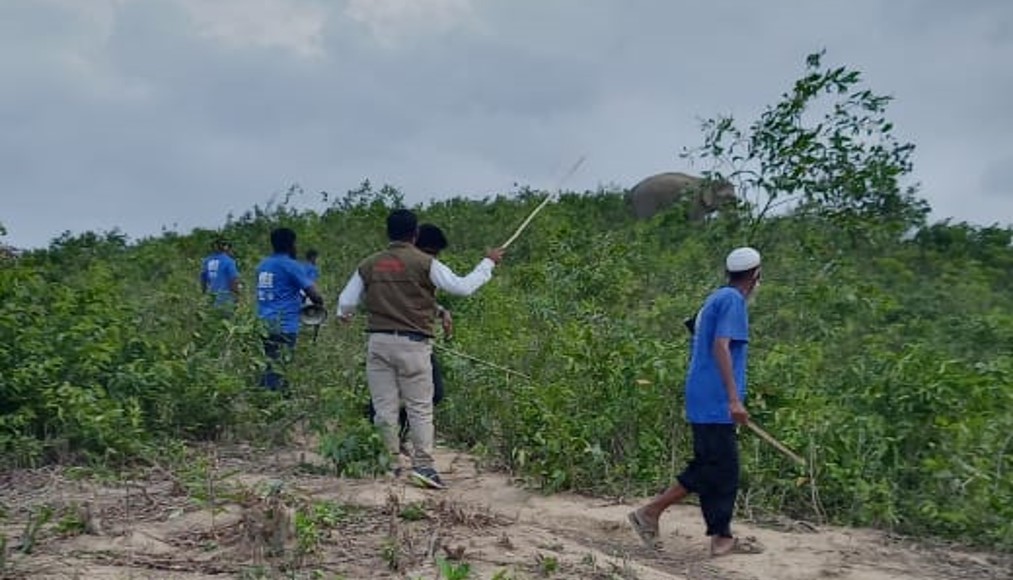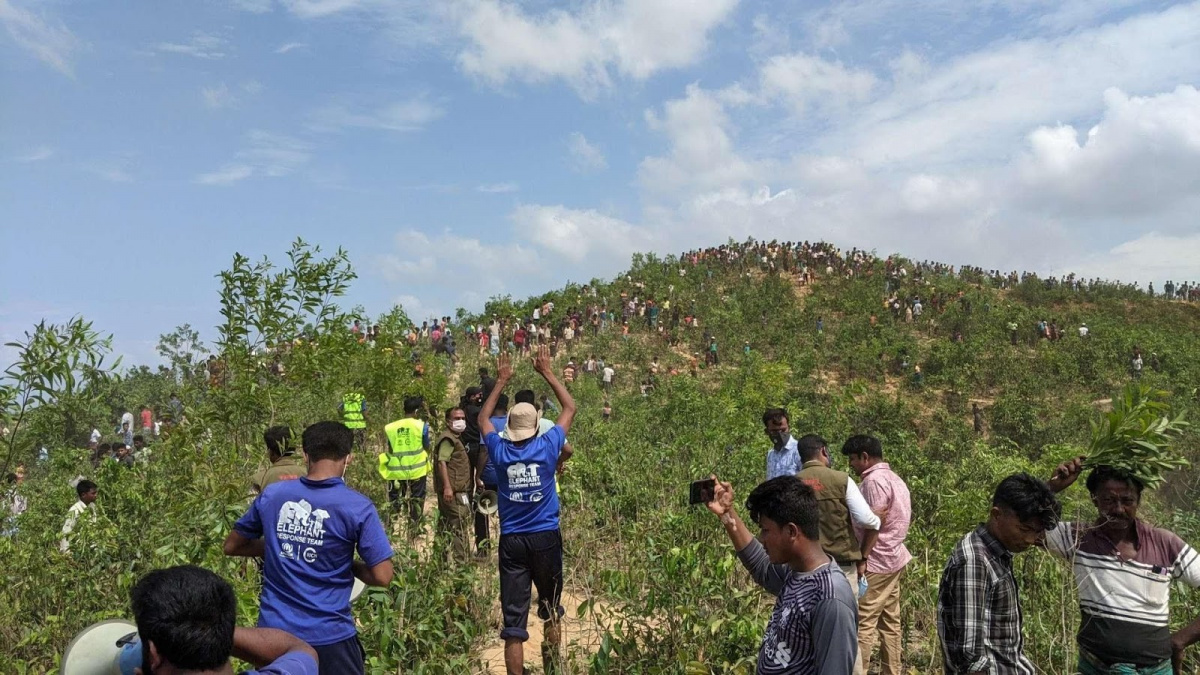Social Cohesion and Wildlife Conservation in a Humanitarian Crisis Setting: A Joint Response by Government Agencies, Host Communities and ERTs from Refugee Communities in Mitigating Human-Elephant Conflict
IUCN has been working with UNHCR since 2018 to mitigate human-elephant conflict (HEC) around the refugee camps in Cox’s Bazar through Rohingya Elephant Response. Due to IUCN interventions, no elephant or human causality happened around the refugee camps despite 262 incidences of elephant intrusion happened until May 2021. However, outside the refugee camps, from January 2020 until June 2021, newspaper, local community, and Bangladesh Forest Department sources have reported that 12 (twelve) elephants died in Cox’s Bazar from human-elephant conflict. A successful joint response by government agencies, host communities, and refugee ERTs has shown the need for a coordinated and multi-stakeholder approach for HEC mitigation both around the refugee camps and nearby host community areas.
Despite its clearly established importance as a keystone species, most elephant populations are fragmented and pocketed due to multidimensional threats and challenges across its ranges. Bangladesh is one of the 13 Asian Elephant range countries and holds the responsibility to contribute to the global effort for conserving this wildlife. According to the IUCN Red List Report 2020, Asian elephant populations have suffered at least a 50% reduction due to the loss and degradation of their habitats. At present, the Asian elephant population in Bangladesh ranges from 210-330 (average 268) and it is categorized as Critically Endangered.
The species that were once widespread in Bangladesh is mostly restricted in the southeast region of the country now. However, different human interventions along with the sudden influx of Rohingya refugees since 2017 have created an environmental crisis in the area endangering the Asian elephants. The world’s largest refugee camp for Rohingya refugees from Myanmar has been established on the only known migration corridor connecting habitats in Bangladesh and Myanmar. On the other hand, habitats and the elephant corridors in Cox’s Bazar North Forest Division and Chittagong area are facing rapid fragmentation and degradation. As a result, nowadays, the death and injury of both humans and elephants have become common phenomena in the southeast region of Bangladesh.
IUCN has been working with the Rohingya refugee community since 2018 to mitigate human-elephant conflicts as part of their “Humanitarian-conservation actions for biodiversity protection around Rohingya refugee camps, Cox’s Bazar” project, supported by UNHCR. As of today, ERTs trained by IUCN Cox’s Bazar team have successfully managed almost all the HEC incidences and protected camp communities and their households from elephant attacks. As the HEC incidences are on the rise in the host community areas, IUCN and UNHCR have expanded their ERT operations in the host community areas in consultation with the Forest Department. The objective is to develop a coordinated approach in dealing with HEC.
One such HEC incidence happened on 25 May 2021 when one adult female wild elephant had made its way to Thaingkhali, Ukhiya adjacent to the boundaries of camps 13 and 14 of the Rohingya Refugee camp in Cox’s Bazar. The elephant was successfully sent back to the forest after 16-hours-long collaborative efforts by Bangladesh Forest Department (BFD), IUCN, CiC Office, Upazilla Administration, Bangladesh Police, and Rapid Action Battalion (RAB) team, local community, and ERT members from the adjacent Rohingya camps.
The elephant was first noticed by the Elephant Response Team (ERT) volunteer, Rowshan Ali from watchtower 40 of camp 13 during their regular night duties. He immediately contacted other ERT members of the adjacent watch towers and jointly tried to push the elephant back to the forest. Due to the low visibility at night and restriction of the movement beyond the army fence, they could not be certain whether the elephant actually moved to the forest. In the early morning of the following day, the elephant was spotted once again on a nearby hill of Thaingkhali adjacent to the boundary of camps 13 and 14. The news quickly spread among the local community and a huge crowd gathered around within a short period of time. In the meantime, the information was also passed to the local BFD officials (Beats, Range, and Divisional offices); and the respective Camp in Charge (Camp- 13 and 14), UNO, and Upazilla Chairman offices.
The DFO, Cox’s Bazar South Forest division sought support from IUCN to tackle the huge crowd and ensure safe passage of the elephant. With the prior permission of respective CiC and Site managements and with the direct interventions of BFD field level officials, IUCN deployed trained ERT members to deal with these emergency situations. IUCN staffs were also present and guided the ERT members to manage the crowd and push back the elephant simultaneously. However, the task was very challenging as the crowd encircled the elephant and obstructed its way to the forest. BFD official and CiC of Camp 13 further requested Bangladesh Police and RAB to manage this huge crowd.
Eventually, in the evening, the crowd started to thin out with the continued efforts by the Bangladesh Police, RAB, and BFD officials. The ERT members also participated in crowd management. The ERT members finally were able to perform their elephant deterrent activities properly and successfully pushed the elephant back to the forest at around 7:00 pm. A potential crisis could be avoided and no damage to property or life was reported. BFD appreciated the effort of the Rohingya ERT members in tackling the emergency situation and saving the lives of both humans and elephants.
Several challenges were identified by the ERTs in deterring elephant intrusion; including human interference during elephant intrusions like shouting, throwing bricks, firecrackers, and blocking the path of the elephant; human presence inside the forest beat boundary. Due to multifaceted challenges, the joint response has been found as the only effective way to ensure social cohesion between refugee and host communities with similar awareness and skill in addressing HEC incidences. It is necessary to sensitize law enforcement agencies to get support during the elephant deterring process and providing logistics support to BFD especially the hand mike, whistle, and torchlight. Capacity development of BFD personnel on elephant deterring techniques as well as forming and training the host community ERTs are essential. The joint response built on the capacity to act and willingness to cooperate by different government agencies, host community members, and ERTs from refugee communities has demonstrated that coordinated efforts can save precious wildlife and create social harmony in conflict-prone and environmentally stressed areas.






